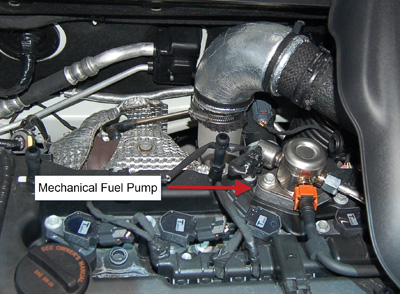 By Omar Trinidad, Assistant Professor,
By Omar Trinidad, Assistant Professor,
Southern Illinois University Carbondale
Due to the conflict between consumer performance demands and more stringent EPA standards, the use of Direct Injection technologies has started to seep its way into the gasoline internal combustion engine (ICE) market.
This trend can be seen through products such as the Ford Taurus, Volkswagen GTI and the Lexus IS lineup. With rumors about corporate average fuel economy (CAFE) requirements increasing to the 40 and 60 miles per gallon range by 2025, the use of Gasoline Direct Injection (GDI) is here to stay.
Now the question is: how will this affect the service side? There are several mechanical, electrical and functional distinctions that technicians need to know when working on GDI vehicles. Furthermore, numerous issues have sprung up over the years concerning fuel system problems and deposit buildup on the intake valves. 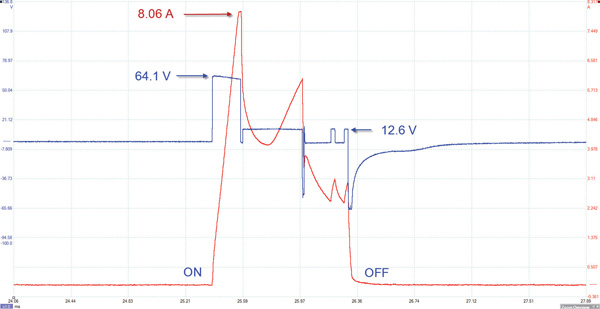
Mechanical
At first glance, a GDI engine appears mechanically similar to a non-GDI system. But it starts to look very different once the plastic covers are removed and the electronics are tested.
The first oddity to be seen is a solenoid-controlled mechanical fuel pump that can step up fuel pressure from 65 psi (448 kPa) to anywhere between 220 and 2,150 psi (1,516 and 14,823 kPa).
See Figure 1.
The low pressure side still utilizes an electric fuel pump and a returnless configuration similar to the Port Fuel Injector (PFI) systems. A module monitors a fuel pressure sensor on the low pressure side to control low-side fuel pressure.
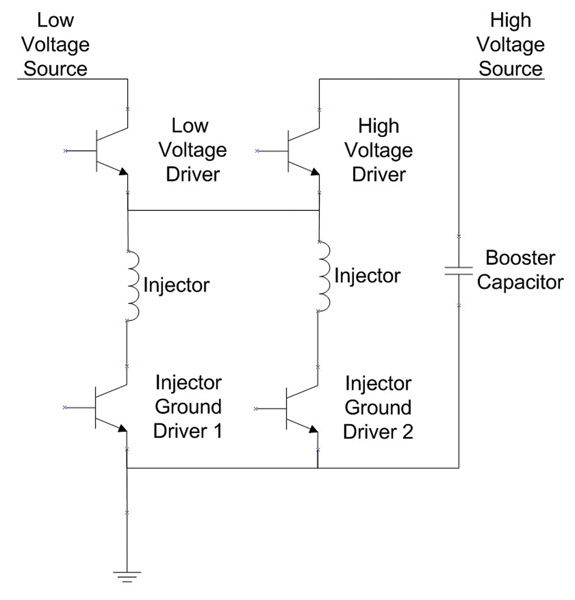 The same module also controls a spill valve solenoid to control high-side fuel pressure.
The same module also controls a spill valve solenoid to control high-side fuel pressure.
A special gasoline direct injection-fuel system tester (DI-FST), which is about $1,400, will be needed for diagnostics.
For most GDI vehicles, the fuel injectors are very difficult to access.
Most manufacturers are utilizing low impedance (low resistance) injectors for their quick response.
But, it is very possible that the manufacturers will soon start to integrate piezo injectors, currently used in common rail diesel applications, that are able to switch up to five times faster than the conventional solenoid type injectors.
GDI injectors are designed with nozzles that spray at an angle to allow the fuel to swirl within the cylinder. This swirl effect allows for a better mixture and an increase in efficiency. The swirl effect is further increased with the use of specially shaped pistons and vanes in the intake runner.
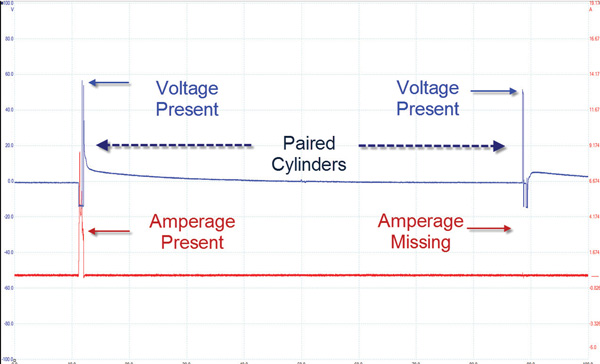 Although there are great benefits from having the lean burn attribute of the GDI systems, they are more susceptible to cold-start problems.
Although there are great benefits from having the lean burn attribute of the GDI systems, they are more susceptible to cold-start problems.
To address this problem Lexus has designed its six-cylinder 2GR-FSE engine, found in the IS350, GS350 and GS450h models, with six direct injectors and six port injectors.
The port injectors are utilized in conjunction with the direct injectors to improve cold-start conditions and increase power by richening the air/fuel mixture.
For the six-cylinder 4GR-FSE engine, found in the IS250, Lexus designed the engine with only a cold-start injector to compensate for cold-start situations.
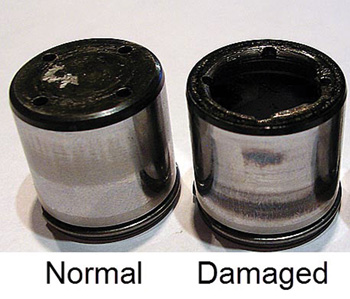
Electrical
Direct injection systems are actuated very differently from conventional PFI systems. Most manufacturers utilize a higher voltage, two shared power drivers and individual ground drivers. It is normal to see voltage readings of 60-65 volts on these systems.
The computer, usually the Power Control Module (PCM), utilizes capacitors and several transistors to step-up the voltage and control injector on-time.
Toyota actuates its injectors through an Injector Driver Unit (EDU). In this system, the PCM indicates to the EDU when and how long to turn on each injector.
The initial high voltage is only used to open the pintle. After the high voltage peak, the voltage drops to charging voltage and the PCM or EDU controls the pulse width to control injector current flow.
See Figure 2.
The current ramps up after the high voltage peak and dramatically drops when voltage drops to 12 volts. The amperage never drops to zero until the injector is fully off.
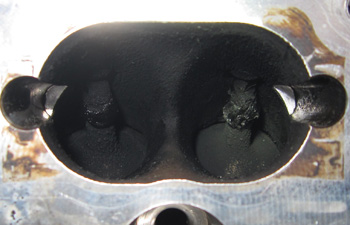 Unlike non-GDI systems, each injector is controlled on both the positive and negative side of the circuit. In addition, most systems are designed with two injectors sharing two positive drivers.
Unlike non-GDI systems, each injector is controlled on both the positive and negative side of the circuit. In addition, most systems are designed with two injectors sharing two positive drivers.
One driver is used for the high voltage needed to open the pintle and the other used for the lower voltage used to keep the injector open.
Figure 3 illustrates a simplified schematic of the system. This is similar to the paired cylinders design used on waste-spark ignition systems.
One of the advantages to pairing two injectors together is the utilization of the sister cylinders inductive kick to recharge the capacitor.
Some technicians diagnosing a misfire on a GDI vehicle might be stumped by the scope reading shown on Figure 4.
The scope pattern illustrates how the current reading skips every voltage reading due to the sister cylinder design.
While the scope patterns might look odd compared to non-GDI systems, technicians can still apply their scope reading diagnostic knowledge to diagnose GDI faults. The best way to use a scope on a GDI system is to focus mainly on the amperage readings while using the voltage readings as a guideline.
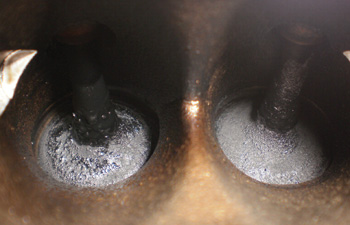 Due to the high voltage used on the GDI system, technicians must be cautious when using an oscilloscope. Technicians must always use an attenuator to prevent any harmful voltage spikes from harming the oscilloscope.
Due to the high voltage used on the GDI system, technicians must be cautious when using an oscilloscope. Technicians must always use an attenuator to prevent any harmful voltage spikes from harming the oscilloscope.
Furthermore, caution must be used when using multichannel oscilloscopes due to their common ground design. Some manufacturers do not specify the positive and negative side of their injector circuit.
This might lead to some confusion, causing the common ground within the oscilloscope to complete the circuit between two injectors being tested.
Functional
Each manufacturer has designed its GDI systems to function with several modes to increase efficiency or power. This is accomplished by controlling when and how long the injectors are turned on.
Although each manufacturer identifies its GDI system with its own terminologies and modes, homogeneous and stratified are two terms that most manufacturers adopt to distinguish air/fuel mixture strategies.
Homogeneous, also known as homogeneous charge, is the term used when the air and fuel mixture is injected during the intake stroke.
This allows for an evenly distributed air/fuel mixture that is applied when more power is needed or to warm the engine and catalytic converter.
Homogeneous stoichiometric is the terminology used when the air/fuel mixture is closer to stoichiometric or slightly richer. Homogeneous lean is used when the air/fuel mixture is leaner.
Stratified, also known as stratified charge, is the term used for an air and fuel mixture that is injected during the compression stroke.
The stratified charge allows the GDI system to achieve its highest efficiency gains through ultra lean air and fuel mixtures in the 60:1 or higher range. More efficiency gains can be achieved by utilizing electronic throttle control and variable valve timing.
Some manufacturers have designed throttle-less engines to increase efficiency by decreasing pumping loss.
GDI Issues
Although there are numerous advantages with GDI, there are several issues that must be addressed. GDI systems have experienced fuel delivery system and intake valve carbon deposit buildup issues that cause driveability and performance problems.
Several recalls and TSBs have been implemented to resolve these issues.
Volkswagen experienced cam follower failures in its Fuel Stratified Injection (FSI) engine caused by excessive friction and design flaws.
See Figure 5
The worn cam follower would fail and allow the fuel pump shaft to rest directly onto the cam lobe.
This would cause the cam lobe to wear and fuel pressure to decrease. This problem would normally cause the MIL to illuminate.
The cam follower issue was corrected in the Turbo Stratified Injection (TSI) engine by utilizing a roller design cam follower instead of the tappet type. In addition, Volkswagen published TSB 2015153 to resolve this issue on the FSI engines.
One of the first signs of a failing cam follower is a code P0087 (Fuel Rail/System Pressure Too Low). This code is usually accompanied by driveability issues, loss of power and lower fuel economy.
Most P0087 problems are associated with a mechanical failure in the fuel pump system. However, this code can also be caused by sensor failure and other electronic issues.
Carbon deposit buildup on the intake valve was one of the unforeseen issues prior to the implementation of the GDI system.
See Figure 6
Previously, PFI systems sprayed fuel before or onto the intake valve. This allowed the fuel to clean the valve every time it sprayed fuel into the port.
Conversely, the GDI systems inject the fuel directly into the cylinder, leaving the intake valve vulnerable to deposit buildup. This issue has been prevalent since its inception. However, the problem has started to become more apparent in the industry due to the recent increase of GDI vehicles.
The carbon buildup in the GDI systems can be associated with valve seal seepage, positive crankcase ventilation (PCV) fumes and unburned fuel from the swirling air/fuel mixture in the cylinder.
Figure 7 is a picture of an intake valve from a GDI vehicle that was cleaned 10,000 miles earlier. Notice that the deposits are on the valve stem and intake manifold port walls.
Although the deposits on both the intake valve and manifold can be associated with fumes from the PCV system and unburned fuel, the deposits on the valve stem can also be attributed to valve seal seepage.
Symptoms relating to excessive carbon buildup are very similar to carbon buildup problems on non-GDI systems. Depending on the severity of the problem, excessive carbon buildup can cause random misfires, decrease in fuel economy, rough idle, long cold starts and a lack of power.
The measures that have been taken to service the intake valve deposit problem span from induction
system cleaning solutions to cylinder head replacement.
In a Lexus TSB, L-SB-0029-10, technicians were instructed to pour a cleaning solution inside the cylinder. Similarly, companies such as BG have developed GDI cleaners that require less engine disassembly.
Some manufacturers are using walnut shells as an abrasive to clean the deposits. There have been cases where the valves were severely coated with carbon and were not sealing properly.
In those cases, the cylinder head was replaced with a new or refurbished cylinder head.
As the number of GDI vehicles on the road start to increase, it is very important for technicians to understand the various systems and have the proper diagnostic tools to service these vehicles.
Caution must be taken when working on the high pressure side of the fuel system. Furthermore, it is very important to monitor both current and voltage with an oscilloscope to diagnose fuel injector malfunctions.
There are always advantages and disadvantages when technology advances. For now, the next step is GDI.












